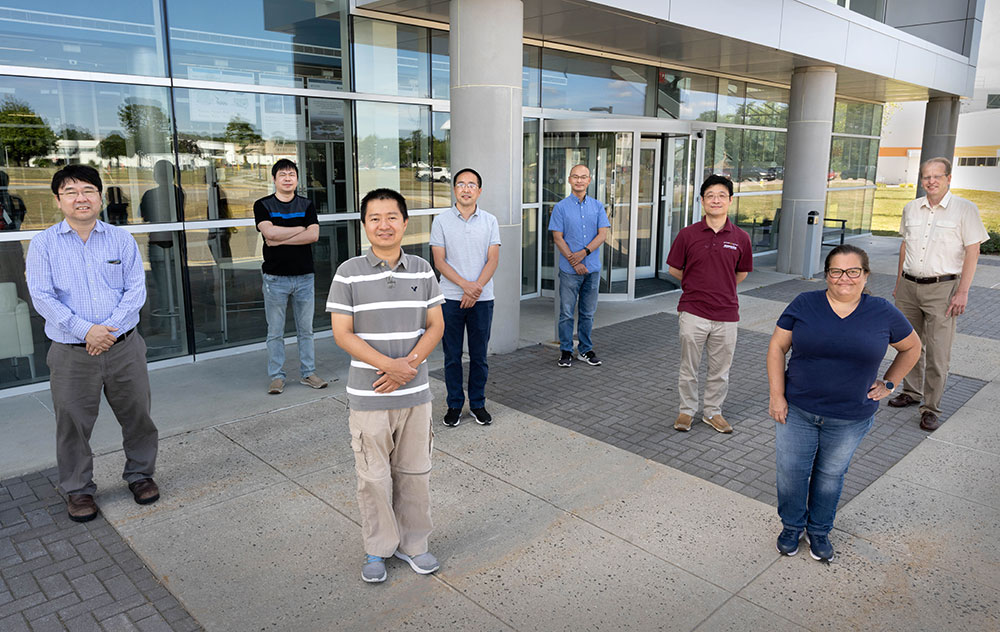Brookhaven Lab Researchers Win 2022 Microscopy Today Innovation Award
The NSLS-II-led team developed a set of bonded x-ray lenses to overcome a long-standing alignment issue, making nanometer resolution more accessible than ever before
August 23, 2022
 enlarge
enlarge
The members of the development team in front of NSLS-II. From left to right: Yong Chu, Hanfei Yan, Weihe Xu, Wei Xu, Xiaojing Huang, Ming Lu, Natalie Bouet, Evgeny Nazaretski. Not pictured: Juan Zhou and Maxim Zalalutdinov.
UPTON, NY—On Aug. 3, 2022, scientists at the U.S. Department of Energy’s (DOE) Brookhaven National Laboratory received the 2022 Microscopy Today Innovation Award for their development of a system with bonded x-ray lenses that make nanoscale resolution more accessible than ever before. When the team at the National Synchrotron Light Source II (NSLS-II), a DOE Office of Science user facility, tested the new lens system, they achieved a resolution down to approx. 10 nanometers.
“We need technologies of the future to tackle some of society’s biggest challenges — from microelectronics to tiny qubits for quantum computers to longer-lasting batteries,” said John Hill, NSLS-II Director. “However, to develop these new devices, researchers need to study materials at the nanoscale. And this where these new lenses really come into their own. They make focusing hard x-ray beams down to a few nanometers much easier than ever before. By using the very focused x-ray beams that these lenses produce, we can reveal the function, structure, and chemistry of next-generation materials on the nanoscale. This crucial breakthrough was only made possible through years of intense work by experts—who are world-leaders in their respective fields—working together. I am delighted that their work has been recognized by this award and very proud to have this new lens system at NSLS-II."
 enlarge
enlarge
A nanofabricated silicon template holds two independent MLLs with high-precision and accurate alignment.
The new lens system consists of two multi-layer Laue lenses (MLLs) set into a microfabricated silicon template that ensures few millidegrees of angular alignment between the two lenses and micron level placement accuracy along the x-ray beam direction. When it comes to x-ray optics, MLLs are among the best one-dimensional lenses for hard x-rays available. However, one MLL is only able to focus a beam in one dimension. This means researchers always need two lenses to create a single focus point.
“If you have two independent MLLs—like the ones we currently use at the Hard X-ray Nanoprobe (HXN) beamline at NSLS-II—you need a sophisticated instrument with high stability just to align them in order to achieve nanometer resolution. “ said Hanfei Yan, a beamline scientist at the Hard X-ray Nanoprobe (HXN) beamline and part of the development team for the bonded MLL system. “Each lens can move in four different ways. The slightest vibration or misalignment will blur the focus spot. So, aligning two lenses to achieve nanoscale resolution currently requires us to use very expensive and bulky solutions.”
While HXN has been using two independent lenses for years now, the team knew that it wanted to make the alignment process easier without sacrificing the precious resolution an extraordinary beamline such as HXN can achieve. HXN itself won the Microscopy Today Innovation Award in 2016, but the team continued to search for a better solution for aligning MLLs.
“We used microfabrication technologies to develop our monolithic 2D MLL system. The new system dramatically reduces the design constraints and complexity of the MLL microscope,” explained Wei Xu, a scientist at NSLS-II and lead developer of the lens system. “Furthermore, the new system is compatible with other conventional and widely used x-ray microscopy systems. This makes high-resolution x-ray imaging more accessible— for various beamlines at NSLS-II and at other light sources.”
Once the team fabricated the monolithic lenses, they tested them at HXN to verify their alignment. These measurements showed them that they had reached ~5 millidegrees of angular alignment between two lenses and micron-level precision of placement along the x-ray beam direction, yielding the resolution of ~10 nanometers.
“As a team, we feel very proud and honored to receive the Microscopy Today Innovation award. This achievement manifests the hard work and dedication exhibited by all members of our multidisciplinary team,” said Evgeny Nazaretski, a scientist and leader of the development team.
Nazaretski added, “as a next step, we are planning to further improve the fabrication process and make templates with even higher angular and lateral positioning accuracy. The ultimate goal would be to enable sub-10 nm resolution for direct x-ray imaging and provide these optics to other imaging beamlines at NSLS-II and other light source facilities within the DOE complex.”
The entire development team includes Wei Xu, Weihe Xu, Nathalie Bouet, Juan Zhou, Hanfei Yan, Xiaojing Huang, Yong Chu, and Evgeny Nazaretski from NSLS-II as well as Ming Lu from the Center for Functional Nanomaterials (CFN) at Brookhaven Lab and Maxim Zalalutdinov from the Naval Research Lab.
Brookhaven National Laboratory is supported by the U.S. Department of Energy’s Office of Science. The Office of Science is the single largest supporter of basic research in the physical sciences in the United States and is working to address some of the most pressing challenges of our time. For more information, visit https://energy.gov/science.
Follow @BrookhavenLab on Twitter or find us on Facebook.
2022-20773 | INT/EXT | Newsroom










